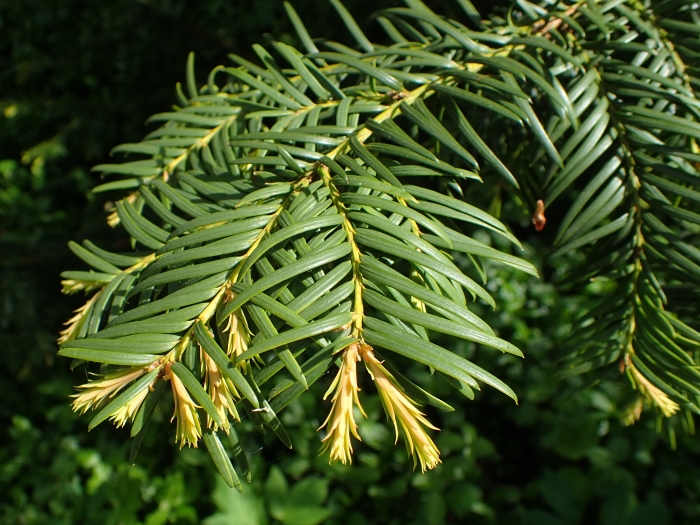Common Yew
(Taxus baccata)
Common Yew (Taxus baccata)
/
/

Krzysztof Ziarnek, Kenraiz
CC BY-SA 4.0
Image By:
Krzysztof Ziarnek, Kenraiz
Recorded By:
Copyright:
CC BY-SA 4.0
Copyright Notice:
Photo by: Krzysztof Ziarnek, Kenraiz | License Type: CC BY-SA 4.0 | License URL: https://creativecommons.org/licenses/by-sa/4.0 | Uploader: Kenraiz | Publisher: Wikimedia Commons | Title: Taxus_baccata_'Semperaurea'_kz03.jpg | Notes: Uploaded own work with UploadWizard |

















































































Estimated Native Range
Summary
Taxus baccata, commonly known as Common Yew, is an evergreen tree or shrub native to the understory of deciduous forests, often found in limestone soils across Europe, North Africa, and Southwest Asia. It can grow 10–20 m (35–65 ft) tall, with a trunk up to 2 m (6 ft 7 in) in diameter. The bark is thin, scaly brown, peeling off in small flakes. The dark green, linear leaves are arranged spirally on the stem and are highly toxic if ingested. Yews are mostly dioecious with separate male and female plants, but some can change sex over time. The red aril surrounding the seed is the only non-toxic part of the plant.
Common Yew is valued for its dense, dark green foliage and its ability to withstand severe pruning, making it ideal for formal hedges and topiary. It is also used in foundation plantings and as a dark backdrop in borders. The slow growth rate of Taxus baccata means it requires less frequent trimming, typically once per year in late summer. It thrives in a range of soil types, including shallow chalk, and tolerates shade, urban pollution, cold, and heat. However, it is susceptible to root rot caused by Phytophthora cinnamomi in waterlogged soils. It prefers full sun to part shade and does well in soils with various drainage levels.CC BY-SA 4.0
Common Yew is valued for its dense, dark green foliage and its ability to withstand severe pruning, making it ideal for formal hedges and topiary. It is also used in foundation plantings and as a dark backdrop in borders. The slow growth rate of Taxus baccata means it requires less frequent trimming, typically once per year in late summer. It thrives in a range of soil types, including shallow chalk, and tolerates shade, urban pollution, cold, and heat. However, it is susceptible to root rot caused by Phytophthora cinnamomi in waterlogged soils. It prefers full sun to part shade and does well in soils with various drainage levels.CC BY-SA 4.0
Plant Description
- Plant Type: Shrub, Tree
- Height: 4-30 feet
- Width: 2-8 feet
- Growth Rate: Slow
- Flower Color: N/A
- Flowering Season: Non-Flowering
- Leaf Retention: Evergreen
Growth Requirements
- Sun: Full Sun, Part Shade
- Water: Medium
- Drainage: Slow, Medium, Fast
Common Uses
Bird Garden, Border Plant, Deer Resistant, Drought Tolerant, Hedges, Low Maintenance, Potted Plant, Rabbit Resistant, Rock Garden, Salt Tolerant, Street Planting
Natural Habitat
Understory of deciduous forests, often found in limestone soils
Other Names
Common Names: English Yew, Irish Yew, European Yew, Tis Cervený, Almindelig Taks, Eibe, Beereneibe, Gemeine Eibe, Gewöhnliche Eibe, If
Scientific Names: , Taxus baccata, Taxus fastigiata, Taxus nana, Taxus columnaris, Taxus baccata f. stricta, Taxus baccata var. fastigiata, Taxus pendula, Taxus baccata var. stricta, Taxus tardiva
GBIF Accepted Name: Taxus baccata L.